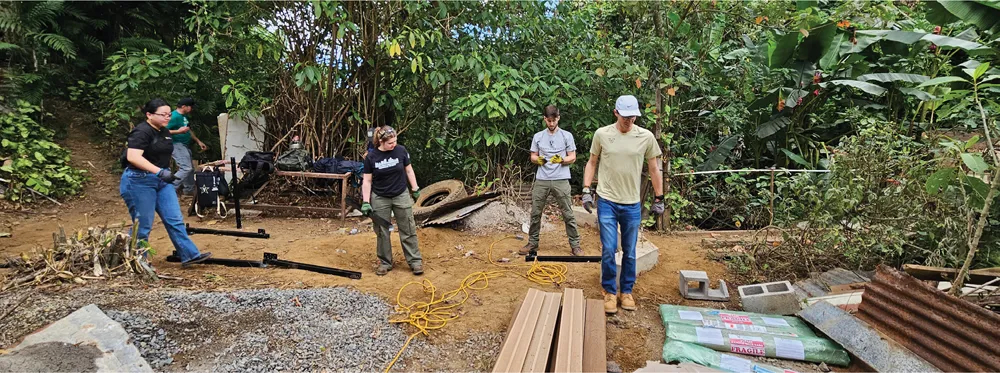
For their senior design project, Zachary Hodges and three of his fellow civil engineering classmates – Logan Glazier, Winnie Huang, and Elise Puliafico – wanted to build something that could make a positive impact in the real world. They landed on a plan to construct a pedestrian bridge over a small creek to help ease safety concerns of local residents.
The only problem: The project was located thousands of miles away in a remote town in Costa Rica. As featured in a recent story about the experience in Modern Steel Construction, the flagship magazine of the American Institute of Steel Construction, the students not only had to transport all the necessary materials and (TSA-friendly) tools on their Southwest Airlines flight from Nashville, they also had to assemble the structure in just one day.
Hodges said the 20-foot-long, 5-foot-wide bridge was particularly beneficial to nearby families and elderly residents. He said the previous structure people used to cross a local creek was dilapidated and had become a hazard.
 The students initially reached out to several volunteer organizations about their idea, and Maximo Nivel – a Latin American-based study abroad and educational travel organization – responded with an outline for the project. Hodges said the group’s civil engineering classes focused on structures and they wanted a hands-on project that drew on what they had learned throughout their four years in the classroom.
The students initially reached out to several volunteer organizations about their idea, and Maximo Nivel – a Latin American-based study abroad and educational travel organization – responded with an outline for the project. Hodges said the group’s civil engineering classes focused on structures and they wanted a hands-on project that drew on what they had learned throughout their four years in the classroom.
“It was incredibly fulfilling to see the countless hours of design, fabrication, and prep truly come together for a family that desperately needed a solution,” said Hodges, who graduated in May and is currently a bridge design engineer at Kimley-Horn in Atlanta, Georgia. “There was an entire family that watched us put together our bridge—something that they didn’t think would actually happen—with so much joy and curiosity.”
John Hastings, a senior bridge engineer at Brentwood, Tennessee-based HDR and one of the advisers on the project, was quoted in the Modern Steel Construction story saying, “I’ve never seen a senior design class design, fabricate, and build a project that benefits a community or individual … This is rare.”
Learning Beyond the Classroom
Hodges credited professor Lori Troxel’s structural design course for preparing them for the task. He also said professor Curtis Byers’ courses on advanced steel design, advanced concrete design, and foundation and substructure design helped them understand building codes, perform the proper analyses, and make informed engineering judgments. Additionally, he said Glazier and Huang were a part of the ASCE/AISC Steel Bridge competition for each of their four years at Vanderbilt and used the design knowledge from those experiences for this senior design project.
“This group of students had a unique combination of experience, compassion, creativity, motivation, and willingness to learn that made this project successful,” Troxel said. “I am so grateful that the Vanderbilt Civil and Environmental Engineering Department and Immersion Vanderbilt supported this endeavor.”